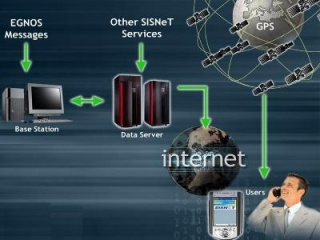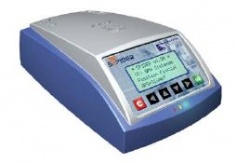If you wish to contribute or participate in the discussions about articles you are invited to contact the Editor
SISNET
| EGNOS | |
|---|---|
| Title | SISNET |
| Author(s) | GMV. |
| Level | Basic |
| Year of Publication | 2011 |
SISNeT is a technology that combines the powerful capabilities of satellite navigation and the Internet. The highly accurate navigation information that comes from the EGNOS (European Geostationary Navigation Overlay Service) Signal-In-Space (SIS) is now available over the Internet and in real time via SISNeT.[1]
EGNOS broadcasts augmentation signals for GPS through Geostationary Earth Orbit (GEO) satellites. GEO broadcasting is proved to be an efficient strategy for avionic applications and other modes of transport. For some applications, though, it may be of interest to complement GEO broadcasting through other transmission means. For instance, building obstacles in cities or rural canyons may difficult the GEO reception. In those situations, complementary real-time Internet-based broadcasting of the EGNOS signal is of major interest as a way to continue taking the most of the EGNOS potential, irrespectively of the user environment.[2]
Responding to that need, ESA developed and launched the SISNeT service in 2002. SISNeT allows retrieving the EGNOS messages across the Internet in real-time, usually through wireless networks, like GSM or GPRS. Thanks to SISNeT, any user with access to the Internet (e.g. through wireless GSM or GPRS networks) may access the EGNOS product, irrespectively of the GEO visibility conditions.
SISNeT Advantages
In the early days of SISNeT, advanced simulation activities revealed that the combination of EGNOS and the almost unlimited capabilities of the Internet could open the door to a lot of innovative applications for Satellite Navigation. The evolution of SISNeT to the date has demonstrated and justified what simulations were anticipating, mainly thanks to:
- The launch of a number of ESA contracts with European industry, on SISNeT developments.
- The interest of worldwide companies, organisations and universities on applying SISNeT to a large variety of applications, research and development projects.
- The ESA internal work on SISNeT.
In fact, new application fields based on SISNeT have been identified, like educational applications, help to impaired people, quick initialisation of SBAS receivers, etc. The possibilities of SISNeT have revealed to be beyond ESA initial expectations.
On the other hand, the Scientific and Engineering community may find major advantages in using SISNeT: the EGNOS signal can be received and processed without having to invest in an EGNOS receiver. Just a connection to the Internet is necessary. These benefits are also applicable to Educational environments (e.g. laboratory exercises based on the EGNOS signal do not imply acquiring receivers, only requiring computers connected to the Internet).
Another advantage is centred in the low bandwidth requirements of SISNeT: the transfer rate ranges from 300 bps to 700 bps, being 470 bps the average value. These characteristics make SISNeT very adequate to be used with GSM / GPRS wireless networks.
Current SISNeT Status
For a wide range of EGNOS applications it may be of interest to complement GEO broadcasting through other transmission means. For instance, building obstacles in cities or rural canyons may difficult the GEO reception. In those situations, complementary means of broadcasting (e.g. FM, Digital Audio Broadcasting – DAB – and the Internet) have a remarkable interest. In this context, the European Space Agency (ESA) launched an internal project to provide access to the EGNOS messages in real time through the Internet. The product of this project has been a new technology, called SISNeT (Signal in Space through the Internet), whose interest has greatly grown since the initial SISNet service was put in place by ESA in 2001.
A first prototype of the SISNeT concept was set-up by the ESA GNSS-1 Project Office, in 2001. Since February 2002, the SISNeT service is accessible through the open Internet, via an authentication procedure. SISNeT accounts are free of charge, and can be requested by contacting the SISNeT team at SISNET@esa.int. Each account consists on a username, a password, the IP address of the SISNeT Data Server and the port to use. The SISNeT project is managed from the EGNOS Project Office (Toulouse, France), where the full platform design and development takes place. Maintenance of the SISNeT platform components is performed from the ESA ESTEC centre (Noordwijk, The Netherlands).
Providing online access to sharpened satnav accuracy, ESA’s SISNeT system has entered its 10th year of operations.[3]
Deployed SISNeT Applications
The SISNeT project can grant important advantages to the GPS land-user community as a user equipped with a GPS receiver and a GSM (or GPRS) modem can access the SISNeT services, thus being able to benefit from the EGNOS augmentation signals, even under situations of GEO blocking. A series of SISNeT based projects have been successfully completed, some of which are briefly described hereafter:[2]
- Handheld SISNeT receiver.[4] [5] [6] This device is based on a Pocket PC Personal Digital Assistant (PDA) device. It includes a GPS card, and the Internet is reached through a GSM / GPRS wireless modem. Specific software is embedded, combining GPS measurements with the EGNOS corrections got via SISNeT. As a result, position accuracy is considerably improved.
- SISNeT technology applied to fleet management.[7] A one-box handheld SISNeT receiver was developed, based on a Psion NetPad device, equipped with the Windows CE .net operating system.A mechanical adaptation was made to integrate a GPS receiver chipset. The link to the Internet is achieved through an integrated GSM / GPRS modem. Almost any commercial GIS software can be used with SISNeT positioning, thanks to a specific driver.
- Application of the SISNeT technology to help blind pedestrians. This activity consisted on assessing the feasibility of applying the SISNeT concept to improve the performance of a navigation device for the blind. The selected device, called TORMES, was developed by the Spanish company GMV Sistemas and ONCE (the Spanish organisation for the blind) before the start of the activity.[8] [9]
Potential SISNeT Applications
ESA has also identified additional benefits that could be obtained from SISNeT, remarking the following:
- The indoor penetration of wireless networks as GSM or GPRS offers a lot of benefits for SBAS receiver initialisation. For vehicles, the SBAS receiver can be initialised in the garage, being ready to use (with EGNOS corrections) once reaching the street.
- In addition, when crossing long tunnels (or other segments with no GPS / GEO satellite visibility) SBAS/SISNeT receiver can start getting the necessary information before leaving the tunnel, since GSM /GPRS signals are normally accessible before reaching the exit. Considering the capability to retrieve previously broadcast messages via SISNeT, the SBAS system can be immediately used after leaving the tunnel in most of the cases, and the benefits of GEO ranging available without delay, just immediately after the EGNOS GEO(s) are again in visibility.
- Prior to reaching the urban environment (e.g. while a vehicle is in the garage or a person is inside a building), the GPS ephemeris information can be initialised from SISNeT, instead of waiting for the GPS message to be received (once on the urban scenario), reducing very much then the time to first fix.
However, SISNeT remains a prototype system, with no guaranteed service levels. In order to cover this necessity, EGNOS Data Access Service (EDAS) is offering reliable performance levels on a warranty basis.
EDAS has been developed by the European Commission with ESA technical support and it offers a next step for services initially based on SISNeT.
Notes
References
- ^ ESA SISNeT Portal
- ^ a b The ESA SISNeT Project: Current Status and Future Plans; Félix Torán-Martí and Javier Ventura-Traveset ESA GNSS-1 Project Office. European Space Agency (ESA). Toulouse (France).
- ^ ESA news on SISNeT System
- ^ Handheld Internet-Based EGNOS Receiver: The First Product of the ESA SISNET Technology; F. Toran, J. Ventura-Traveset and R. Chen; GNSS 2003, Graz (Austria), 22 – 25 April 2003.
- ^ Access to the EGNOS Signal In Space Over Mobile-IP; R. Chen, F. Toran-Marti and J. Ventura-Traveset. GPS Solutions (2003).
- ^ Space technology to help the blind; ESA Press Release, 30 December 2003, available at (http://www.esa.int/export/esaSA/SEM4HZ1A6BD_navigation_0.html).


